The approximate 6,000 ships that have succumbed to raging storms attest to the power of the Great Lakes. As I traveled, writing and compiling information for my three-volume travel series that explores Michigan's coasts, I heard or read the tales left behind by those ill-fated ships. They add a somber, but compelling backdrop to Michigan’s waterways. This week’s article isn’t about a specific ship. It’s about a place where many doomed vessels disappeared.
In 1950, the tale of the Bermuda Triangle was spawned. It claimed that an area in the North Atlantic Ocean swallowed ships and planes, leaving behind no trace of the unfortunate craft and crews. Scientists, non-scientists, and just plain hucksters began hypothesizing about what caused the disappearances. Most of us enjoy a good mystery or the suggestion of supernatural happenings, so the stories proliferated. Truth or urban myth, they are more entertaining than dry scientific explanations for baffling events.
Less publicized is the Lake Michigan Triangle. With its own secrets and treachery, it tells stories to rival those of the better-known Bermuda Triangle. Since this is a series of articles about some of the most riveting tales of shipwrecks on the Great Lakes, it seems appropriate to add a few words about where many met their demise.
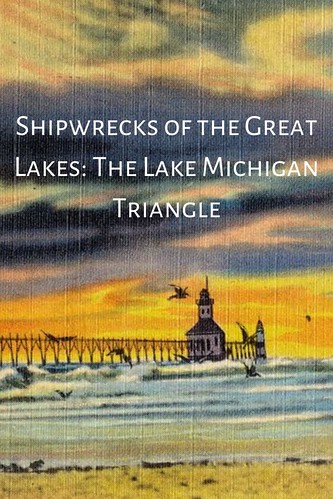
The surface area of the Lake Michigan Triangle is created by connecting its three vertices: Ludington to Benton Harbor and then to Manitowoc, Wisconsin. It is a dangerous region where huge ships and even a commercial airline have vanished. The Shipwreck Alley in Lake Huron and the Shipwreck Coast of Lake Superior are daunting, but Lake Michigan, because of her Herculean currents, is considered the most dangerous of the Great Lakes.
Charles Berlitz, a supporter of Bermuda Triangle theories, believed Lake Michigan was subjected to forces similar to those in the Bermuda Triangle. Jay Gourley in his book, The Great Lakes Triangle, said, “The Great Lakes account for more unexplained disappearances per unit area than the Bermuda Triangle.” Substantiation for this proposition is difficult, based on a variety of factors including sloppy reporting. Statistics aren’t always corrected when a ship is later located. And in some situations, the resting place of a lost ship is claimed by more than one lake.
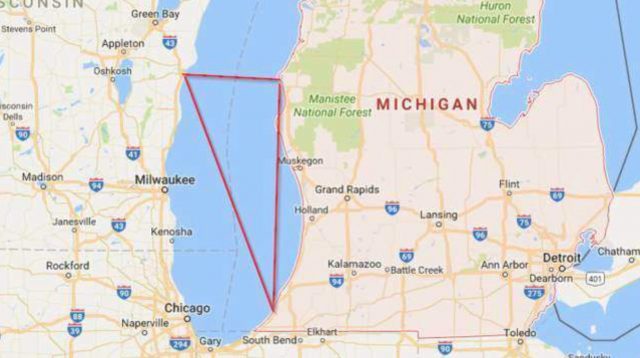
Boundaries of the Lake Michigan Triangle. (Photo Credit: Click On Detroit / Google Maps)
Le Griffon is an example. She was possibly the first large ship to disappear in the Lake Michigan Triangle. In September 1679, Le Griffon headed a course from Lake Michigan to Lake Erie. There are numerous theories about the fate of Le Griffon. Whatever the cause—mutiny, theft, or bad weather—it is generally believed she sank in the waters defined as part of the Lake Michigan Triangle, but conclusive evidence of her final resting place has not been established. She may have gone down in Lake Huron, as proposed by Cris Kohl and Joan Forsberg in their 2015 book, The Wreck of the Griffon.
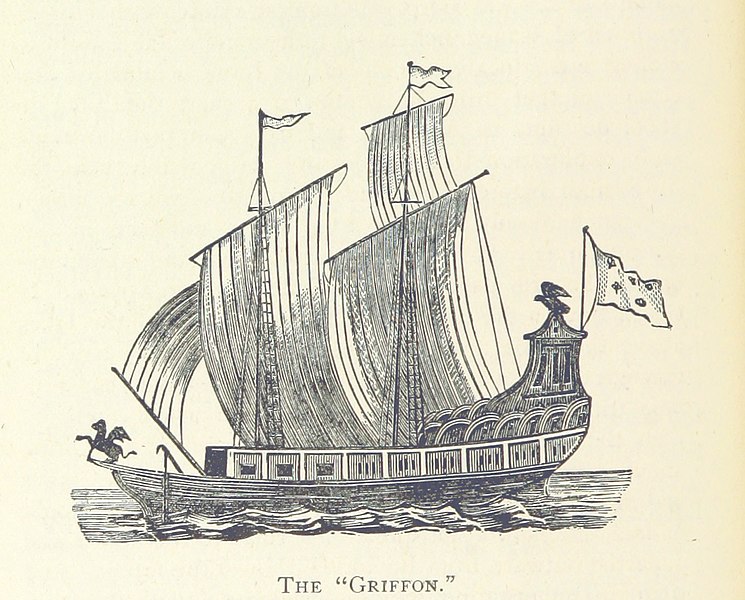
"Annals of Fort Mackinac," Kelton, Dwight H., 1882
Whether or not the Griffon was first, it is certain she wasn’t the last to succumb to the deadly stretch of water that became known as the Lake Michigan Triangle. On May 21, 1891, the three-masted schooner, Thomas Hume, was sailing to her home port in Muskegon. The Hume never made it. More interesting, after exhaustive searches, not a trace of her crew or wreckage was found in the days, weeks, and months after her disappearance.

The schooner Thomas Hume before she sank
Elizabeth Sherman, great-granddaughter of the ship’s namesake, Thomas Hume, wrote Beyond the Windswept Dunes: The Story of Maritime Muskegon. Sherman’s story attempts to explain the final voyage of the Hume which, on its last voyage, was in the company of the Rouse Simmons. The weather turned ugly, and the Simmons turned back to Chicago. The Hume continued on alone. Until she disappeared. The Thomas Hume was not discovered at the bottom of the lake until 2006, more than a century after she was lost. After that much time, she was still in near-perfect condition. You can see photos here.
In a Triangle irony, two decades later, in November 1912, the Rouse Simmons, known as the Christmas Tree Ship because of her cargo, also succumbed to the hungry waters of Lake Michigan’s Triangle. For a year, there was no trace of the Simmons. Then Christmas trees begin to wash up along the shore, and a fisherman hauled in an unusual catch: the wallet of the Rouse Simmons’ captain. The Rouse-Simmons was found sunken in 165 feet of water with no sign of what took her down into the depths of the lake.
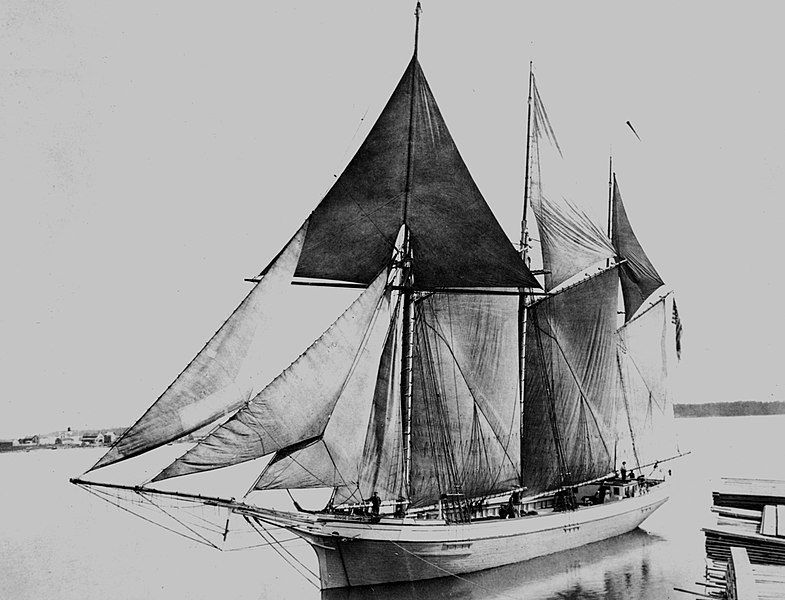
The schooner Rouse Simmons prior to her sinking
The tally of ships lost in the Triangle is long, and the stories are awash in speculation and misinformation. The list includes the Lady Elgin, the Rosa Belle, and the Carl D. Bradley. And the Lake Michigan Triangle has claimed more than just shipwrecks. Northwest Airline flight 2501 disappeared without a trace in June 1950.
V.O. van Heest, co-founder of the Michigan Shipwreck Research Associates, based out of Holland, Michigan, authored Fatal Crossing (2013). She recounts what is known of the crash. She teamed up with author and explorer Clive Cussler in a quest to solve the mystery of the plane’s final minutes. The question was never answered, although van Heest penned an interesting read.
In the shallow waters of the triangle, archaeologists have even discovered a stone structure said to resemble the famous Stonehenge.
Creative minds have explained the Lake Michigan Triangle with spooky accounts of the paranormal. The practical among us might argue the disappearances and strange occurrences are more likely the result of powerful currents, human error, or the Lake’s infamous November storms. Either way, it is true that the lake can swallow you whole. And that is pretty scary.
More resources:
https://www.thevintagenews.com/2021/06/24/lake-michigan-triangle/
http://www.michiganshipwrecks.org/
https://www.alpenalibrary.org/greatlakesmaritime
https://research.lib.buffalo.edu/greatlakes/shipwrecks
https://greatlakes.bgsu.edu/
https://storymaps.arcgis.com/stories/a7910b2eaa04450aaff93fa9de4821b8
Click through to read excerpts from Royce's three books exploring Michigan's coasts:
Julie Albrecht Royce, the Michigan Editor for Wandering Educators recently published a three-book travel series exploring Michigan’s coastlines. Nearly two decades ago, she published two traditional travel books, but found they were quickly outdated. This most recent project focuses on providing travelers with interesting background for the places they plan to visit. Royce has published two novels: Ardent Spirit, historical fiction inspired by the true story of Odawa-French Fur Trader, Magdelaine La Framboise, and PILZ, a legal thriller which drew on her experiences as a First Assistant Attorney General for the State of Michigan. She has written magazine and newspaper articles, and had several short stories included in anthologies. All books available on Amazon.
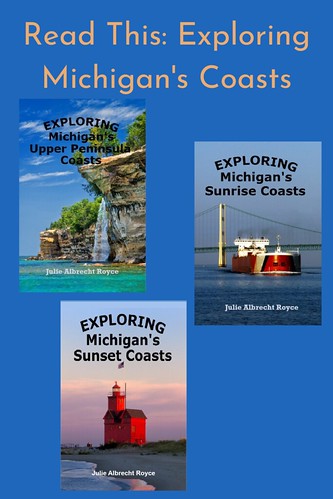
Help promote Michigan. Books available on Amazon.
All photos in the Public Domain courtesy Wikimedia Commons, except where noted.

